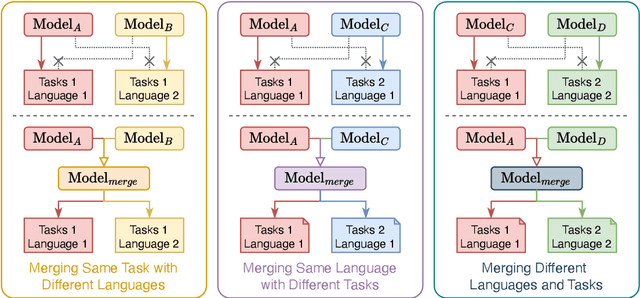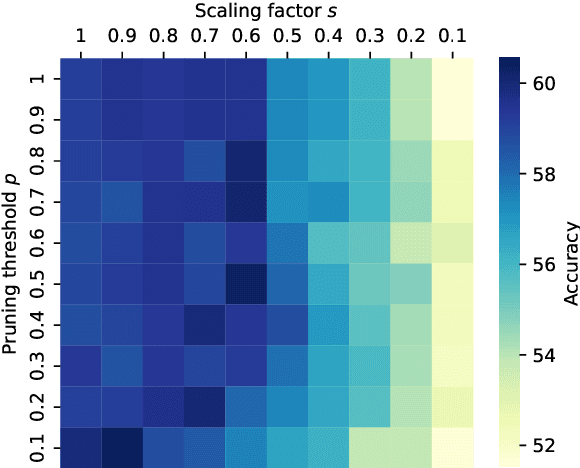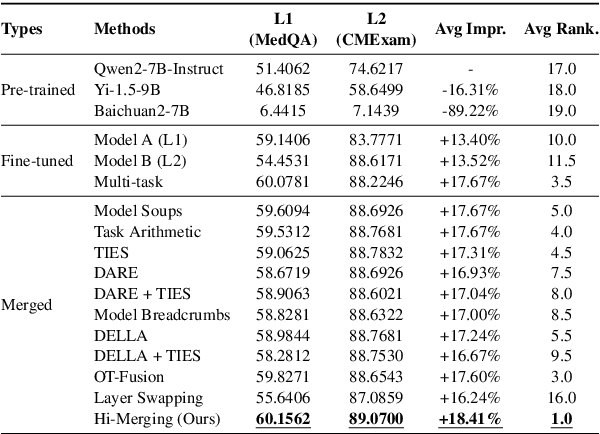Hongzhi Yin
The University of Queensland
Relational Database Distillation: From Structured Tables to Condensed Graph Data
Oct 08, 2025Abstract:Relational databases (RDBs) underpin the majority of global data management systems, where information is structured into multiple interdependent tables. To effectively use the knowledge within RDBs for predictive tasks, recent advances leverage graph representation learning to capture complex inter-table relations as multi-hop dependencies. Despite achieving state-of-the-art performance, these methods remain hindered by the prohibitive storage overhead and excessive training time, due to the massive scale of the database and the computational burden of intensive message passing across interconnected tables. To alleviate these concerns, we propose and study the problem of Relational Database Distillation (RDD). Specifically, we aim to distill large-scale RDBs into compact heterogeneous graphs while retaining the predictive power (i.e., utility) required for training graph-based models. Multi-modal column information is preserved through node features, and primary-foreign key relations are encoded via heterogeneous edges, thereby maintaining both data fidelity and relational structure. To ensure adaptability across diverse downstream tasks without engaging the traditional, inefficient bi-level distillation framework, we further design a kernel ridge regression-guided objective with pseudo-labels, which produces quality features for the distilled graph. Extensive experiments on multiple real-world RDBs demonstrate that our solution substantially reduces the data size while maintaining competitive performance on classification and regression tasks, creating an effective pathway for scalable learning with RDBs.
TableDART: Dynamic Adaptive Multi-Modal Routing for Table Understanding
Sep 18, 2025Abstract:Modeling semantic and structural information from tabular data remains a core challenge for effective table understanding. Existing Table-as-Text approaches flatten tables for large language models (LLMs), but lose crucial structural cues, while Table-as-Image methods preserve structure yet struggle with fine-grained semantics. Recent Table-as-Multimodality strategies attempt to combine textual and visual views, but they (1) statically process both modalities for every query-table pair within a large multimodal LLMs (MLLMs), inevitably introducing redundancy and even conflicts, and (2) depend on costly fine-tuning of MLLMs. In light of this, we propose TableDART, a training-efficient framework that integrates multimodal views by reusing pretrained single-modality models. TableDART introduces a lightweight 2.59M-parameter MLP gating network that dynamically selects the optimal path (either Text-only, Image-only, or Fusion) for each table-query pair, effectively reducing redundancy and conflicts from both modalities. In addition, we propose a novel agent to mediate cross-modal knowledge integration by analyzing outputs from text- and image-based models, either selecting the best result or synthesizing a new answer through reasoning. This design avoids the prohibitive costs of full MLLM fine-tuning. Extensive experiments on seven benchmarks show that TableDART establishes new state-of-the-art performance among open-source models, surpassing the strongest baseline by an average of 4.02%. The code is available at: https://anonymous.4open.science/r/TableDART-C52B
Proxy Model-Guided Reinforcement Learning for Client Selection in Federated Recommendation
Aug 14, 2025Abstract:Federated recommender systems have emerged as a promising privacy-preserving paradigm, enabling personalized recommendation services without exposing users' raw data. By keeping data local and relying on a central server to coordinate training across distributed clients, FedRSs protect user privacy while collaboratively learning global models. However, most existing FedRS frameworks adopt fully random client selection strategy in each training round, overlooking the statistical heterogeneity of user data arising from diverse preferences and behavior patterns, thereby resulting in suboptimal model performance. While some client selection strategies have been proposed in the broader federated learning literature, these methods are typically designed for generic tasks and fail to address the unique challenges of recommendation scenarios, such as expensive contribution evaluation due to the large number of clients, and sparse updates resulting from long-tail item distributions. To bridge this gap, we propose ProxyRL-FRS, a proxy model-guided reinforcement learning framework tailored for client selection in federated recommendation. Specifically, we first introduce ProxyNCF, a dual-branch model deployed on each client, which augments standard Neural Collaborative Filtering with an additional proxy model branch that provides lightweight contribution estimation, thus eliminating the need for expensive per-round local training traditionally required to evaluate a client's contribution. Furthermore, we design a staleness-aware SA reinforcement learning agent that selects clients based on the proxy-estimated contribution, and is guided by a reward function balancing recommendation accuracy and embedding staleness, thereby enriching the update coverage of item embeddings. Experiments conducted on public recommendation datasets demonstrate the effectiveness of ProxyRL-FRS.
Watermarking Large Language Model-based Time Series Forecasting
Jul 28, 2025Abstract:Large Language Model-based Time Series Forecasting (LLMTS) has shown remarkable promise in handling complex and diverse temporal data, representing a significant step toward foundation models for time series analysis. However, this emerging paradigm introduces two critical challenges. First, the substantial commercial potential and resource-intensive development raise urgent concerns about intellectual property (IP) protection. Second, their powerful time series forecasting capabilities may be misused to produce misleading or fabricated deepfake time series data. To address these concerns, we explore watermarking the outputs of LLMTS models, that is, embedding imperceptible signals into the generated time series data that remain detectable by specialized algorithms. We propose a novel post-hoc watermarking framework, Waltz, which is broadly compatible with existing LLMTS models. Waltz is inspired by the empirical observation that time series patch embeddings are rarely aligned with a specific set of LLM tokens, which we term ``cold tokens''. Leveraging this insight, Waltz embeds watermarks by rewiring the similarity statistics between patch embeddings and cold token embeddings, and detects watermarks using similarity z-scores. To minimize potential side effects, we introduce a similarity-based embedding position identification strategy and employ projected gradient descent to constrain the watermark noise within a defined boundary. Extensive experiments using two popular LLMTS models across seven benchmark datasets demonstrate that Waltz achieves high watermark detection accuracy with minimal impact on the quality of the generated time series.
When Graph Contrastive Learning Backfires: Spectral Vulnerability and Defense in Recommendation
Jul 10, 2025Abstract:Graph Contrastive Learning (GCL) has demonstrated substantial promise in enhancing the robustness and generalization of recommender systems, particularly by enabling models to leverage large-scale unlabeled data for improved representation learning. However, in this paper, we reveal an unexpected vulnerability: the integration of GCL inadvertently increases the susceptibility of a recommender to targeted promotion attacks. Through both theoretical investigation and empirical validation, we identify the root cause as the spectral smoothing effect induced by contrastive optimization, which disperses item embeddings across the representation space and unintentionally enhances the exposure of target items. Building on this insight, we introduce CLeaR, a bi-level optimization attack method that deliberately amplifies spectral smoothness, enabling a systematic investigation of the susceptibility of GCL-based recommendation models to targeted promotion attacks. Our findings highlight the urgent need for robust countermeasures; in response, we further propose SIM, a spectral irregularity mitigation framework designed to accurately detect and suppress targeted items without compromising model performance. Extensive experiments on multiple benchmark datasets demonstrate that, compared to existing targeted promotion attacks, GCL-based recommendation models exhibit greater susceptibility when evaluated with CLeaR, while SIM effectively mitigates these vulnerabilities.
Training-free LLM Merging for Multi-task Learning
Jun 14, 2025



Abstract:Large Language Models (LLMs) have demonstrated exceptional capabilities across diverse natural language processing (NLP) tasks. The release of open-source LLMs like LLaMA and Qwen has triggered the development of numerous fine-tuned models tailored for various tasks and languages. In this paper, we explore an important question: is it possible to combine these specialized models to create a unified model with multi-task capabilities. We introduces Hierarchical Iterative Merging (Hi-Merging), a training-free method for unifying different specialized LLMs into a single model. Specifically, Hi-Merging employs model-wise and layer-wise pruning and scaling, guided by contribution analysis, to mitigate parameter conflicts. Extensive experiments on multiple-choice and question-answering tasks in both Chinese and English validate Hi-Merging's ability for multi-task learning. The results demonstrate that Hi-Merging consistently outperforms existing merging techniques and surpasses the performance of models fine-tuned on combined datasets in most scenarios. Code is available at: https://github.com/Applied-Machine-Learning-Lab/Hi-Merging.
* 14 pages, 6 figures
Lightweight Embeddings with Graph Rewiring for Collaborative Filtering
May 25, 2025Abstract:As recommendation services scale rapidly and their deployment now commonly involves resource-constrained edge devices, GNN-based recommender systems face significant challenges, including high embedding storage costs and runtime latency from graph propagations. Our previous work, LEGCF, effectively reduced embedding storage costs but struggled to maintain recommendation performance under stricter storage limits. Additionally, LEGCF did not address the extensive runtime computation costs associated with graph propagation, which involves heavy multiplication and accumulation operations (MACs). These challenges consequently hinder effective training and inference on resource-constrained edge devices. To address these limitations, we propose Lightweight Embeddings with Rewired Graph for Graph Collaborative Filtering (LERG), an improved extension of LEGCF. LERG retains LEGCFs compositional codebook structure but introduces quantization techniques to reduce the storage cost, enabling the inclusion of more meta-embeddings within the same storage. To optimize graph propagation, we pretrain the quantized compositional embedding table using the full interaction graph on resource-rich servers, after which a fine-tuning stage is engaged to identify and prune low-contribution entities via a gradient-free binary integer programming approach, constructing a rewired graph that excludes these entities (i.e., user/item nodes) from propagating signals. The quantized compositional embedding table with selective embedding participation and sparse rewired graph are transferred to edge devices which significantly reduce computation memory and inference time. Experiments on three public benchmark datasets, including an industry-scale dataset, demonstrate that LERG achieves superior recommendation performance while dramatically reducing storage and computation costs for graph-based recommendation services.
HMamba: Hyperbolic Mamba for Sequential Recommendation
May 14, 2025Abstract:Sequential recommendation systems have become a cornerstone of personalized services, adept at modeling the temporal evolution of user preferences by capturing dynamic interaction sequences. Existing approaches predominantly rely on traditional models, including RNNs and Transformers. Despite their success in local pattern recognition, Transformer-based methods suffer from quadratic computational complexity and a tendency toward superficial attention patterns, limiting their ability to infer enduring preference hierarchies in sequential recommendation data. Recent advances in Mamba-based sequential models introduce linear-time efficiency but remain constrained by Euclidean geometry, failing to leverage the intrinsic hyperbolic structure of recommendation data. To bridge this gap, we propose Hyperbolic Mamba, a novel architecture that unifies the efficiency of Mamba's selective state space mechanism with hyperbolic geometry's hierarchical representational power. Our framework introduces (1) a hyperbolic selective state space that maintains curvature-aware sequence modeling and (2) stabilized Riemannian operations to enable scalable training. Experiments across four benchmarks demonstrate that Hyperbolic Mamba achieves 3-11% improvement while retaining Mamba's linear-time efficiency, enabling real-world deployment. This work establishes a new paradigm for efficient, hierarchy-aware sequential modeling.
Enhancing Treatment Effect Estimation via Active Learning: A Counterfactual Covering Perspective
May 08, 2025Abstract:Although numerous complex algorithms for treatment effect estimation have been developed in recent years, their effectiveness remains limited when handling insufficiently labeled training sets due to the high cost of labeling the effect after treatment, e.g., expensive tumor imaging or biopsy procedures needed to evaluate treatment effects. Therefore, it becomes essential to actively incorporate more high-quality labeled data, all while adhering to a constrained labeling budget. To enable data-efficient treatment effect estimation, we formalize the problem through rigorous theoretical analysis within the active learning context, where the derived key measures -- \textit{factual} and \textit{counterfactual covering radius} determine the risk upper bound. To reduce the bound, we propose a greedy radius reduction algorithm, which excels under an idealized, balanced data distribution. To generalize to more realistic data distributions, we further propose FCCM, which transforms the optimization objective into the \textit{Factual} and \textit{Counterfactual Coverage Maximization} to ensure effective radius reduction during data acquisition. Furthermore, benchmarking FCCM against other baselines demonstrates its superiority across both fully synthetic and semi-synthetic datasets.
M2Rec: Multi-scale Mamba for Efficient Sequential Recommendation
May 07, 2025Abstract:Sequential recommendation systems aim to predict users' next preferences based on their interaction histories, but existing approaches face critical limitations in efficiency and multi-scale pattern recognition. While Transformer-based methods struggle with quadratic computational complexity, recent Mamba-based models improve efficiency but fail to capture periodic user behaviors, leverage rich semantic information, or effectively fuse multimodal features. To address these challenges, we propose \model, a novel sequential recommendation framework that integrates multi-scale Mamba with Fourier analysis, Large Language Models (LLMs), and adaptive gating. First, we enhance Mamba with Fast Fourier Transform (FFT) to explicitly model periodic patterns in the frequency domain, separating meaningful trends from noise. Second, we incorporate LLM-based text embeddings to enrich sparse interaction data with semantic context from item descriptions. Finally, we introduce a learnable gate mechanism to dynamically balance temporal (Mamba), frequency (FFT), and semantic (LLM) features, ensuring harmonious multimodal fusion. Extensive experiments demonstrate that \model\ achieves state-of-the-art performance, improving Hit Rate@10 by 3.2\% over existing Mamba-based models while maintaining 20\% faster inference than Transformer baselines. Our results highlight the effectiveness of combining frequency analysis, semantic understanding, and adaptive fusion for sequential recommendation. Code and datasets are available at: https://anonymous.4open.science/r/M2Rec.
 Add to Chrome
Add to Chrome Add to Firefox
Add to Firefox Add to Edge
Add to Edge